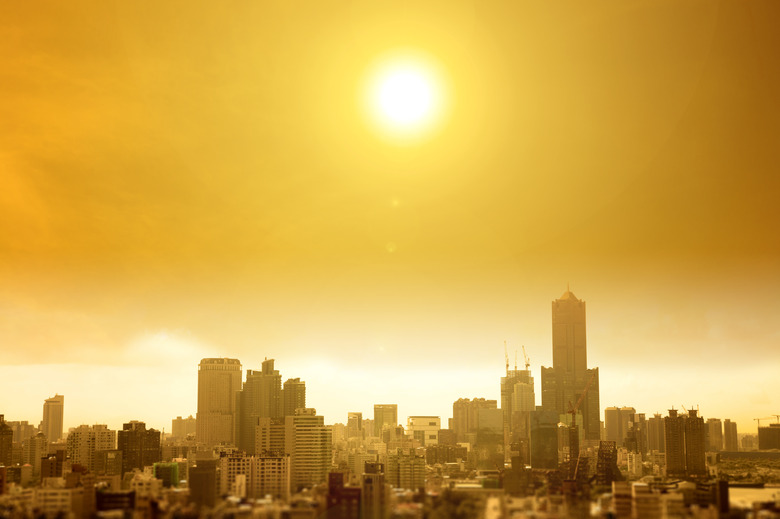How Does Temperature Affect Barometric Pressure?
The term barometric pressure is synonymous with the term air pressure when describing conditions in the atmosphere, and may also be referred to as atmospheric pressure. Like all matter, air is composed of molecules. These molecules have mass and are subjected to the force of Earth's gravity. Air pressure is the weight of air molecules pressing down on you. Inhabitants on Earth's surface bear the weight of all the air molecules in the atmosphere. At higher altitudes, air pressure decreases because there are fewer air molecules pressing down from above compared with the air pressure at sea level.
Measuring Air Pressure
Measuring Air Pressure
Barometric pressure is measured in millibars (mb) but is often given in inches because older style of barometers measured the height of a column of mercury to indicate air pressure. Normal air pressure at sea level is 1013.2 mb, or 29.92 in. An aneroid barometer measures air pressure by the expansion or contraction of springs, housed in a partial vacuum, in response to changes in air pressure. In older mercury barometers, a column of mercury would rise or fall in response to changes in air pressure. Air pressure is constantly changing due to fluctuations in temperature, which is related to air density.
Warm Temperatures
Warm Temperatures
Warm air causes air pressure to rise. When air molecules collide, they exert force on each other. When gas molecules are heated, the molecules move more quickly, and the increased velocity causes more collisions. As a result, more force is exerted on each molecule and air pressure increases. Temperature affects air pressure at different altitudes due to a disparity in air density. Given two columns of air at different temperatures, the column of warmer air will experience the same air pressure at a higher altitude that is measured at a lower altitude in the cooler column of air.
Cool Temperatures
Cool Temperatures
Cool temperatures cause air pressure to drop. When gas molecules cool, they move more slowly. Decreased velocity results in fewer collisions between molecules and air pressure decreases. Air density plays a role in the correlation between temperature and pressure because warmer air is less dense than cool air, allowing molecules to have more space to collide with greater force. In cooler air, the molecules are closer together. The proximity results in collisions with less force and lower air pressure.
Weather Indicators
Weather Indicators
Weather patterns complicate the relationship between barometric pressure and temperature. Meteorologists gather barometric readings and represent them on weather maps with "H" and "L" to indicate areas of high and low pressure. Very cold temperatures can create areas of high air pressure because cold air has greater density and the concentration of molecules can raise the air pressure. An area of higher pressure, H, is called a high-pressure system and generally has a denser air mass where air temperature is cool. These systems often bring warmer temperatures and dry weather. A low-pressure system, L, is an area of less dense air with warmer air temperatures. The lower concentration of molecules causes lower air pressure in these areas. Low-pressure systems often bring cool, wet weather.
Cite This Article
MLA
Mentzer, A.P.. "How Does Temperature Affect Barometric Pressure?" sciencing.com, https://www.sciencing.com/temperature-affect-barometric-pressure-5013070/. 27 April 2018.
APA
Mentzer, A.P.. (2018, April 27). How Does Temperature Affect Barometric Pressure?. sciencing.com. Retrieved from https://www.sciencing.com/temperature-affect-barometric-pressure-5013070/
Chicago
Mentzer, A.P.. How Does Temperature Affect Barometric Pressure? last modified March 24, 2022. https://www.sciencing.com/temperature-affect-barometric-pressure-5013070/
